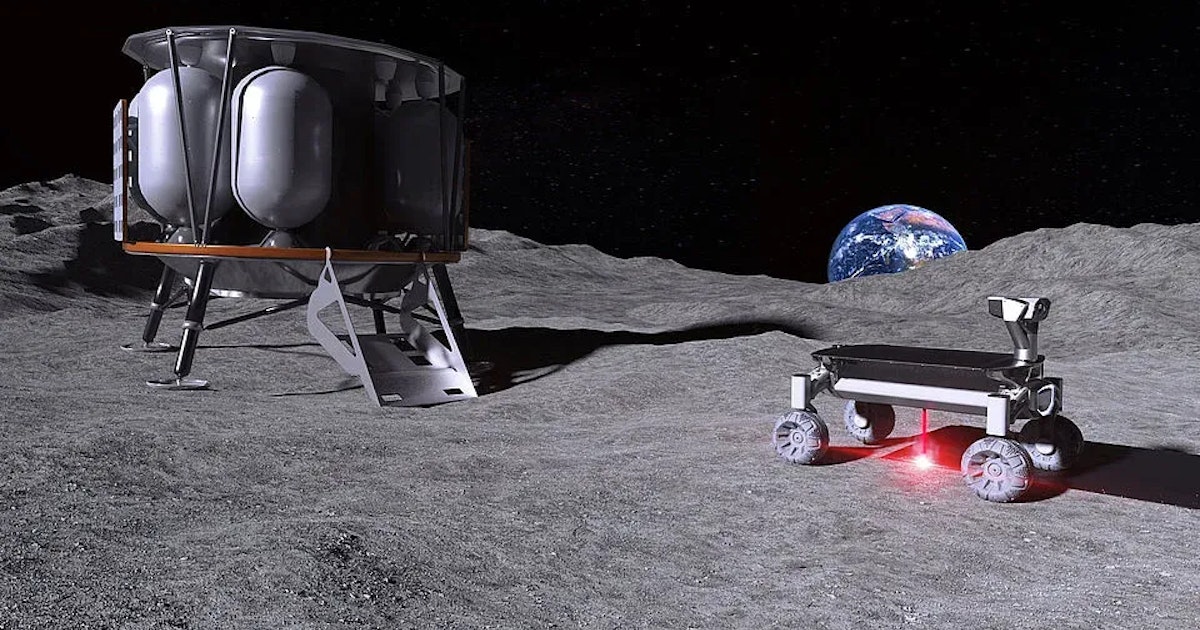Berlin / Hanover – What does man really want on the moon? Some people ask themselves when they look at the big earthly problems. But basically, it’s also reassuring that there are still researchers out there who are motivated by curiosity: to explore the universe further and prepare new space missions – and also to find potential solutions to terrestrial problems.
The Moon is very suitable for such plans – as a potential research station and “staging point” for spaceships. For some time, many space organizations have been considering installing a permanent base on the Moon where people can also live. In this context, the Technical University (TU) Berlin is planning a trip to the moon with the Laser Center Hannover (LZH). The researchers want to test how to build landing pads, roads and buildings on the Moon.
Transporting materials to the lunar station will cost $1 million per kilogram
“At a cost of up to $1 million per kilogram, a complete transfer of material from Earth to the Moon would be very expensive,” says Jörg Neumann, head of the “Moonrise” project at LZH. Therefore, an attempt should be made to erect the structures on the site, using lunar dust, also known as regolith. This is a layer of crushed moon rocks up to fifteen meters thick and has very special properties.
LZH
Newly developed laser on the robotic arm of a lunar rover
Scientists want to bring a laser system to the moon that will melt moon dust. Artificial intelligence (AI) aims to support this process. The lunar experiments aim to lay the foundations for a possible 3D laser printing technology that will one day be able to “print” parts for future infrastructure on the Moon.
Processing locally available materials is also called in situ resource utilization (ISRU) in space travel, TU Berlin reports. It could be “a major factor in advancing lunar and space exploration”. The first foundations for this have already been laid. Because in a previous VW-funded project, researchers had already developed a “compact and powerful laser” and had successfully tested it in the lab on the robotic arm of the lunar rover.
Laser testing in lunar conditions – but on Earth
According to TU, scientists have successfully dissolved real lunar dust in the experiment under lunar gravitational conditions. This happened in the Einstein elevator of an institute at Leibniz University in Hannover. The Moon has only one sixth of the gravitational force found on the Earth. So if you weighed 60 kilograms on Earth, you would weigh only ten kilograms on the Moon. This also has an effect on moon dust, for example, because the falling particles sink back to the surface slowly.
Something like this has to be taken into consideration for future technologies. According to the report, the Einstein elevator – a landing tower more than 20 meters high in Hanover that performs experiments in weightlessness and in vacuum – has succeeded in melting the regolith into coherent structures under lunar gravitational conditions. The laser head was controlled by a rover’s robotic arm, similar to what might be used on the Moon in the future.

LZH
The research team has already succeeded in melting lunar dust into coherent structures using a laser.
A co-researcher said the laser head is about the size of a “big juice can” and can still withstand the adverse conditions in space. Although it is not yet possible to build larger building blocks or even a complete lunar station with “orbits” of melting lunar dust, scientists believe the start has been made.
“Now it’s about making the laser suitable for a lunar flight,” TU Berlin explains. Scientists from LZH and TU have now begun developing a flight model of the laser that is “qualified for use in space”. Artificial intelligence should help with this task. A camera on the moon is supposed to take pictures of molten moon dust, which are then evaluated by scientists on Earth using an intelligent image-processing system. In this way, “artificial intelligence-based process and quality control” should become possible.
A modular system made of moon dust serves as an aid to TU Berlin
This AI must be trained on the ground. TU explains: “At TU Berlin, a laboratory will be set up in which the regolith will be photographed under lighting conditions similar to those on the Moon.” A corresponding set of images is generated from which the AI can learn. “In addition, a regolith-building toolkit has been developed over the past few years, which makes it possible to accurately simulate the characteristics of various potential landing sites.”
The modular system represents the different compositions of regolith at potential landing sites by means of terrestrial rocks. This should then happen at the TU lab, depending on where the lander is parked, so that “laser and AI can be aligned with the real moon mission,” Benedict Griffin of the Exploration and Propulsion Working Group in the TU Space Technology Division explained in Berlin.
A trip to the moon is planned for 2024. Details not provided. The project is called “Moonrise-FM” and will run for three years. It is funded by the Federal Ministry of Economy in the amount of 4.75 million euros. The sponsor of the project is the German Aerospace Center (DLR).
Moon – great danger and hope at the same time
The challenges of living and working on the moon are very great. One reason for this is moon dust, which should not only be used as a building material – you must learn how to work with it first. It sticks to shoes, gloves, and everything that comes in contact with it – apparently due to electrostatic charging from sunlight. This was the experience of the Apollo astronauts, who always brought some dust into the cabin after returning from a moonwalk. They said it was as soft as snow, but “rough” and smelled like spent gunpowder.
lunar regolith It consists of silicon, aluminum, calcium, iron, magnesium, titanium and other materials. It is more like sand than dust. It was created over several billion years by the unbridled bombardment of chunks of space, literally shattering and crushing crustal rock. Solar wind particles – mainly hydrogen, helium, neon, carbon and nitrogen – are stored in lunar dust. One talks about some kind of solar wind archive.
The individual particles are not rounded off by water, wind and weather, but have sharp edges. Also among them are shards of glass from the asteroid collision’s overheating. Lunar dust destroys space clouds and irritates the airways and eyes of astronauts returning from a spacewalk. It can get into seals and mechanical components, and damage optics and solar cells. In a 2005 study, NASA identified lunar dust as the biggest challenge future lunar missions class.
But lunar dust is also a reason why people would consider settling on the moon at all. Economic hopes are focused, among other things, on rare raw materials such as iridium and other metals. Moon dust can act as a storage medium. Helium-3, an extremely rare isotope of the noble gas helium on Earth, could be used in coolants, measuring instruments, and future fusion reactors.
The potential benefits of staying on the moon
In this regard, the eyes of different nations are fixed on the Moon. NASA, in particular, has big plans after announcing the “To the Moon!” course. Back in 2019. Since the Moon’s weaker gravity and lack of atmosphere greatly reduce rocket fuel requirements, the Moon could serve as a platform for manned missions to Mars, for example.
As part of the Artemis program, NASA plans to establish a space station in lunar orbit, with the support of international cooperation. At some point, a lunar station – the so-called Artemis base camp – will be built near Shackleton Crater At the south pole of the moon. It is said that there is always enough sunlight on the high edge of the crater, so that the solar modules can produce enough electricity at any time. In addition, water is suspected in the crater of a volcano four kilometers deep, in the form of ice.

NASA
This is what NASA’s Artemis Base Camp could look like.
But other organizations also want to be there on the moon. In early 2019, for example, a space probe landed on the far side of the moon for the first time: the Chinese probe “Chang’e 4” With a motor vehicle. Other plans so far envisage, among other things, the construction of a Russian-Chinese research station on the lunar surface around the 2030s, in which other partners could also participate. No one knows what will happen in light of the events taking place on the ground.
Astronomers are particularly interested in the far side of the moon. It is here that especially powerful telescopes can be created for further exploration of the Universe, because the observing conditions are very good. But not because the back is “always dark,” as one recent account puts it — which likely stems from Pink Floyd’s “The Dark Side of the Moon.”
No, the sun illuminates all sides of the moon throughout the month. The back remained “dark” for people for a long time because they could only see one side – due to restricted rotation. But when there is a new moon, for example, the moon is between the earth and the sun and shines “from behind”.
The moon is simulated in Cologne
The bottom line is that the far side of the Moon is unaffected by interfering radiation from Earth – radar, Wi-Fi, cell phones, and satellites. At the same time, there is no atmosphere (ionosphere) on the Moon, which basically “swallows” low-frequency radio waves on Earth. For example, you can use a radio telescope on the back of the Moon to make astronomical measurements that are not possible on Earth – for example, exploring the universe as it appeared 300,000 years after the Big Bang.
Years ago, Europeans considered building a large long-wave radio telescope on the far side of the Moon as a first step toward a manned European moon station. Jan Warner, Director General of the European Space Agency (ESA) until February 2021, Already announced “Moon Village” in 2016, which should be open to all interested states. Not much has happened in this direction yet. Europeans are primarily involved in NASA’s current lunar program – providing equipment and technology and possibly with their own astronauts.

DLR / ESA / F. Roomch / CC-BY
Moon view inside the planned Luna Hall in Cologne
However, a lunar training facility will be built at the European Astronaut Center in Cologne to prepare astronauts for extended stays on the moon. The funding decision came from the state of North Rhine-Westphalia in March 2022. The system is called Luna and is a joint venture between Esa and DLR. Among other things, the plan is to replicate the lunar surface in a large hall, lunar dust simulators, day and night simulations, testing facilities for technologies and a housing unit called Future Lunar Exploration Habitat, or FlexHab for short.
By the way, moon dust for the system comes from Germany. It is an alternative to riches volcano powder, which is 45 million years old and originates from volcanic eruptions from the neighboring Eifel region. In doing so, the lunar surface is reproduced in Cologne.
It will likely be a long time before housing is made from real moon dust on the moon — perhaps even as an international collaboration like Jan Warner had in mind in 2016. Right now, there’s a higher risk that the moon will become a kind of dish image The origin of the land: with conflict or even the enmity of competing nations.

“Certified tv guru. Reader. Professional writer. Avid introvert. Extreme pop culture buff.”







More Stories
What are the consequences for medium-sized technology and industrial companies?
The Tech Campus divides the Neuberg Greens-Munich area
New chief data protection officer calls for more courage in digitalization